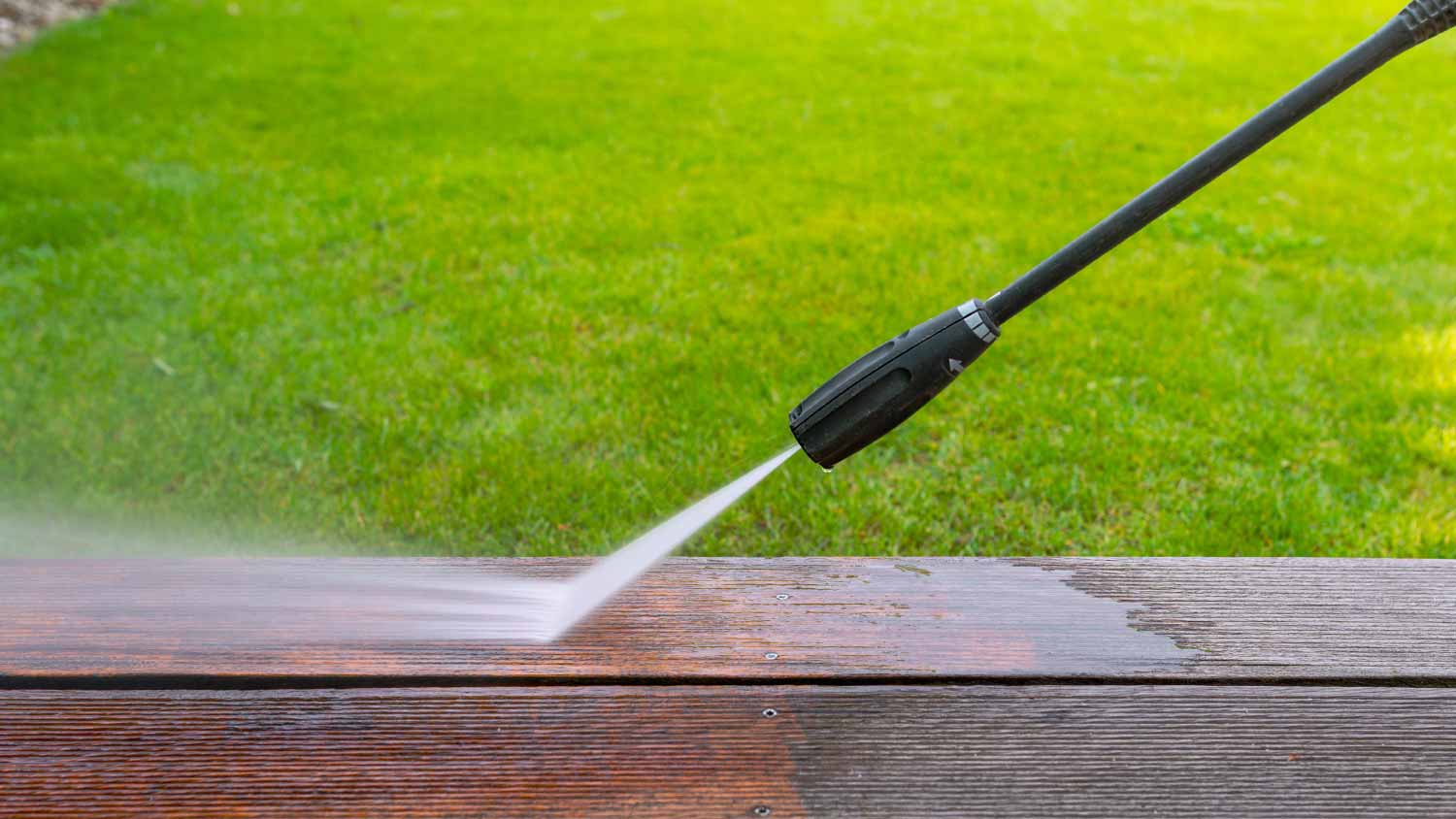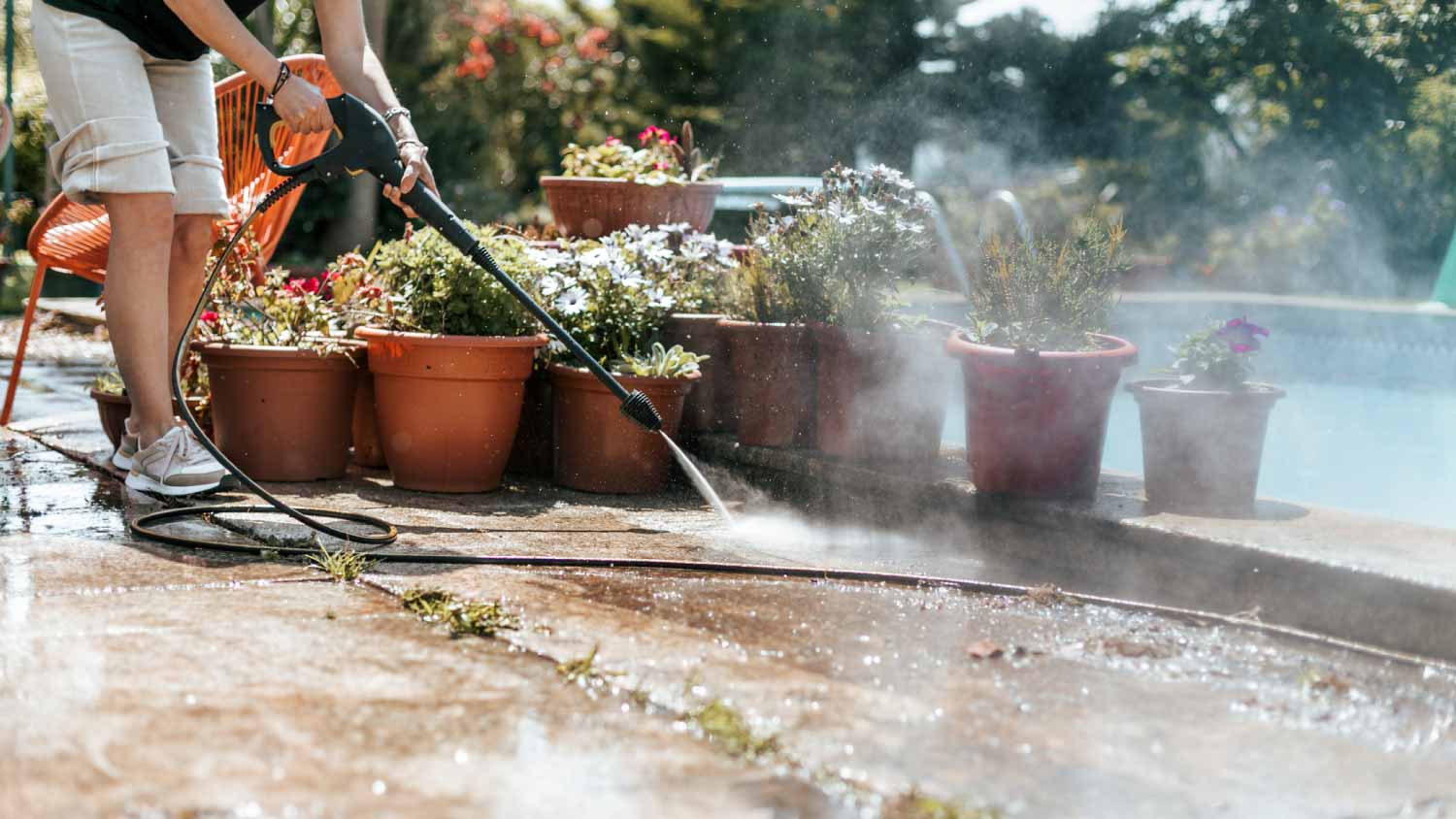
Pressure washers can help you keep your home looking great. Use this guide to learn how much it costs to rent a pressure washer based on factors like type and time.
We’re leaking the names of these oily offenders


Dry O-rings and corroded connections can cause oil to leak through the machine.
You should change the oil every 30–50 hours of use, but a loose drain plug can leak fresh oil and cause you to have to replace it sooner.
After 500 hours of use, you should replace the pressure washer.
A new pressure washer costs between $100 and $1,000.
Imagine you have pressure washing on your to-do list, but when you go to grab the machine from storage, you notice an oil leak under the body of the pressure washer. So much for those weekend DIY plans. So, what would cause a pressure washer to leak oil in the first place? There are several potential causes behind a leaking pressure washer. Here’s what you should check for.
One big enemy to successful pressure washing is dry or cracked O-rings and connectors. Pressure washers have several O-rings, seals, and other connectors to prevent water leaks and keep the machine running smoothly. However, these seals can become brittle and crack, and they’re prone to corrosion. If a seal breaks, it can cause both oil and water to leak from the machine.
If you’re handy, you can buy new O-rings and seals online or at a hardware store and replace them yourself. Otherwise, leave this job to a pro to prevent further oil leaks or extensive damage.
Pistons are located inside the pressure washer’s pump, and they pressurize the water. Pistons have tightly fitting seals, but these seals wear down over time. If even one seal breaks, it can cause water or oil to leak and can cause a drop in water pressure. Watch for oil leaks around the pump or changes to the water pressure to identify a damaged piston seal, which you should replace as soon as possible.

The pump assembly allows the water to flow and become pressurized for deep-cleaning grime off of hard surfaces. This assembly has multiple fittings to prevent water and oil leaks. If you notice oil leaking from the pressure washer pump, it may be a loose or damaged fitting. Tighten any loose fittings or replace broken fittings to stop the oil leak.
If you don’t firmly secure the drain plug after replacing the oil, this can cause that fresh, new oil to leak. Make sure to tighten the drain plug after replacing the oil. If the plug is damaged, replace it to avoid ongoing oil leaks.
The dipstick is what you use to check the oil level on the pressure washer. Because you should be checking the oil level of the pressure washer before each use, the dipstick can be exposed to little bits of dirt and debris. If there’s buildup or a piece of debris on the dipstick, it can keep it from securing tightly into the reservoir.
Pull out the dipstick and check for any debris. Clean it and replace it. Check the O-ring around the dipstick opening and replace it if needed.

Old pressure washer pumps can wear out and cause an oil leak. If you notice oil or water leaking and issues with your pressure washer not starting, it may simply be time for a new pressure washer.
Most pressure washers last for 500 hours of use or around 10 years with light to moderate use and regular pressure washer maintenance. If your pressure washer is nearing those limits, or repairs cost more than half of what a new pressure washer would cost, upgrade to a newer model. New pressure washers cost $100 to $1,000, depending on the model.
Unless the oil leak is from a loose nut or bolt that you can tighten yourself or a seal that’s easy to replace, leave any oil leaks to a pro. Otherwise, you risk damaging your machine, and then you’d have to pay for the cost of a new pressure washer. Oil leaks can also leave pesky stains in your garage and even run off into your prized gardens or lawn if the oil mixes with water in your pressure washer.
By trusting these repairs to a power washing pro near you, the experts can find the source of the leak and patch things up quickly. This means you'll get back to cleaning up your property lickety-split. Whether you DIY or hire a pro for pressure washer repairs, make sure to check the oil level and refill it after repairs and before you use the pressure washer again to avoid disrupting your cleaning jobs.
She is always punctual and does excellent work cleaning my apartment and washing and folding my clothes. She is trustworthy and a very nice lady. I highly recommend her.
Jose Herrera fixed my washing machine and replaced the kitchen garbage disposal carefully and efficiently. I am very happy with my selection.
Alex was professional, friendly, thorough, and fast. He fixed our leaky shower valve and improved our water pressure. Great experience with Fix-A-Leak!
We give our highest recommendation! They were quick to respond and most importantly professional and trustworthy. They did a wonderful move-in job with our previously overgrown front/backyard and they also power washed house. We absolutely will be hiring them as our permanent/recurring...
Good service on the phone. Expensive. I had a bad experience with a battery I bought from them. Picked up the generator to get it fixed at another place.
thorough, friendly, professional. They did a fantastic job power washing 3 buildings and went the extra mile. Highly recommended.
Appointment times mean nothing to Jimmy. If hes going to be late he doesnt let you know. Its all about Jimmy. When he did the washing machine dial repair, he put the dial on backwards and the settings were all messed up. I didnt realize that he did that until the next time I used my...
Dave and his crew were timely, responsive, highly professional, and simply did a great job! The job turned out to be bigger than anticipated, as the majority of the damage behind the stucco was hidden, and the stucco installation done 29 years ago found to be rather poor, allowing water...
Make sure you are aware of the difference in powerwash and pressure wash.
Two highly rated AL companies came out prior to Coolmoon and they were all too eager to sell us a new four ton unit instead of fixing the leak - which they said was impossible. Coolmoon fixed the leak, replaced a faulty valve stem and a sealed a leaky pressure valve. The repairs saved us...
From average costs to expert advice, get all the answers you need to get your job done.

Pressure washers can help you keep your home looking great. Use this guide to learn how much it costs to rent a pressure washer based on factors like type and time.

The cost to pressure wash a patio depends on the size of the surface and the type of patio you have, as well as whether you DIY or hire a pressure washing pro.

Pressure washing your fence can restore its appearance and keep your home looking great. Learn how much it costs based on factors like square footage and material.

Do you need to clean oil, paint, or rust stains on your concrete driveway? Learn if it’s better to spray or not to spray before pressure washing it.

Safely pressure wash your shower or bathtub without damaging your caulking, fixtures, and tiles. Choose the best nozzle and equipment for your needs.

Who power washes houses? Hiring a power washing professional is the best choice, as this expert has the know-how and equipment to do the job correctly.